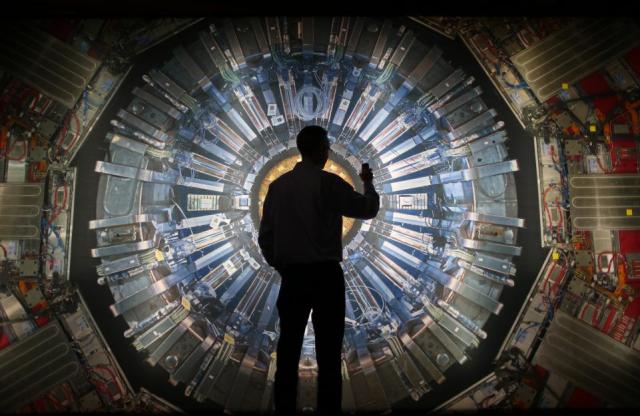Fascinating (Spock ears twitching)
I wonder if you have ever heard of the Z Machine?
 http://www.sandia.gov/z-machine/
http://www.sandia.gov/z-machine/
Sandia’s Z machine is the world's most powerful and efficient laboratory radiation source. It uses high magnetic fields associated with high electrical currents to produce high temperatures, high pressures, and powerful X-rays for research in high energy density science. The Z machine creates conditions found nowhere else on Earth. Z is part of Sandia's Pulsed Power program, which began in the 1960s.
Sandia’s Z machine is Earth’s most powerful pulsed-power facility and X-ray generator.
http://www.sandia.gov/z-machine/about_z/index.html
Z Machine: A Particle Accelerator Hotter than the Sun
http://www.popularmechanics.com/technology/a1285/4212225/
There is a site called
Exit Mundi
http://www.exitmundi.nl/exitmundi.htm
Exit Mundi explores different end of the world scenarios with a chuckle.
Alright, so accidents happen. But the accident that happened today is a rather awful one. Scientists triggered the end of the Universe. By mistake, that is.
It was all supposed to be under control. Sure, in the 1990s, there were some oddball scientists who gave off warnings that things might one day go terribly wrong at the lab. But no-one really cared.
Unfortunately, the oddballs were right. Today, during an experiment in high-energy physics, the inconceivable happened. The experiment triggered what scientists call a quantum vacuum collapse. And one second later, the dreaded phenomenon has wiped out all matter on the planet. The world with everything and everyone on it has simply ceased to exist.
But that's not all. Traveling at the speed of light, a huge wave of destruction sets out from where the Earth used to be. Like the shockwave of a bomb exploding, it flings off into all directions. And everywhere it passes, it brings about mayhem and destruction. Voom! -- there goes the Moon. Slam! -- that was the Sun. Spat! -- Mars, Jupiter, Pluto; all gone. The shockwave never stops. It will expand and expand. And expand, until every molecule in the Universe is dead.
So, what exactly is going on? The answer takes you to the heart of quantum physics: the chunk of science that deals with the tiny particles that make up everything in the Universe. Quantum theory predicts that the Universe is filled with so-called vacuum energy -- which is the average energy of all those zillions of particles that pop into and out of existence everywhere around us each moment. As the Universe expanded, the vacuum energy dropped down to the lowest possible level. Well, in theory, that is.
There is, however, a small possibility that the theory is wrong. The Universe may be still `hung up' in an unstable energetic state. If so, a fierce jolt of energy in just the right place may be exactly what it takes to tip the balance. It would be like putting a needle into a balloon. Within a fraction of a second, a HUGE blast of energy will set free, as the quantum vacuum plunges into a lower energetic state.
The destructive energy that is unleashed will be quite different from everything we know. Literally every atom in our part of the cosmos will spew out energy. You can't even BEGIN to imagine the bizarre consequences this would have. For one thing, ordinary matter will become unstable and cease to exist.
So what would spark off the collapse? Well: particle accelerators, for example. In a particle accelerator, science smashes all kinds of tiny particles into each other to learn more about matter and the Universe. Now that's neat -- but according to critics, there's a real possibility such collisions may yield enough energy to push the Universe off balance. `The Universe can be blown to smithereens', as one of them (Paul Dixon) cosily put it in 1998.
If you find all this hard to understand, don't worry. Even specialized physicists don't fully understand how the quantum vacuum works. So their line of reasoning is simple: everywhere in the Universe, all kinds of atoms, molecules and particles slam into each other constantly. So if the quantum vacuum indeed were unstable, it would have had plenty of opportunity to collapse already. Simply put: the Universe cannot be a barrel of gunpowder, since nature constantly throws all kinds of burning fuses into it.
Phew, that indeed seems reassuring. On the other hand: as some physicists have pointed out, there is also a possibility nature simply hasn't found the right fuse yet. And here on Earth, we're experimenting with all kinds of new fuses -- for example, we're doing and planning particle accelerator experiments with rare elements such as gold and with elements that are so unstable they don't exist in `real' nature.
What's more, accidents happen. And the bigger the science, the bigger the accidents. So please, dear physicists. If you read this, please be a little careful.
There's a fuel supply that is costless, unlimited and that gives off no pollution at all when you use it. There's just one minor problem. When you try to use it, you may accidentally blow up part of the Universe.
It will be over before anyone can say `sorry'. In a laboratory somewhere, someone tries to get hold of a weird and completely new, exotic type of energy. But boy, the experiment goes out of hand. Suddenly, there's a BIG explosion. And then there's nothing -- our planet, the sun, all planets in our solar system and even some stars surrounding our solar system have been blown to smithereens.
And explaining what went wrong isn't even simple. We're talking quantum physics here: the physics of the vanishingly small building blocks that make up all matter in the Universe.
In quantum physics, everything is totally different from daily life. Quantum particles can be in two places at the same time, and can behave both like waves and particles. In fact, when you hear a quantum physicist say `particles', don't think of little, round balls. Quantum `particles' are better compared with tones of music: they're definitely there, but you can't see them or catch them.
One of the most mind-boggling properties of quantum particles is that they come into existence out of nowhere. Suck every molecule of air out of a bottle, making it completely vacuum -- and quantum particles will still be there. They pop up in pairs out of nowhere. And within a tiny fraction of a second, they merge together and -- zzzip! -- they're gone.
It is precisely this odd `quantum vacuum' that may one day open the door to a very new source of energy. Suppose you're able to snatch some of those out-of-nowhere particles away. Admittedly, you'll have to be REALLY fast. But if you do succeed, you'll have harvested particles out of nowhere. And since matter and energy are basically the same stuff (according to Einstein's E=mc2), you'll have energy out of nowhere!
The advantages would be unimaginable. Here's an energy source that never runs out, is everywhere around, is extremely cheap, and causes no pollution whatsoever.
But then again, there is a small, but alarming risk. There may be simply energy too much. Mining the quantum vacuum might bring about an unstoppable chain reaction, releasing an ever increasing amount of energy. In fact, no-one knows how much energy will be released: calculations done by physicists give answers anywhere between zero and infinity.
Obviously, too much energy would mean trouble. The explosion could be huge enough to blow apart our entire solar system and everything around it. And of course, infinite energy would bring about infinite destruction, bombing not just a handful of stars, but everything in the entire Universe.
Gladly, no present-day scientist is capable of mining the quantum vacuum. On the other hand: one day, there will be. And that day may arrive sooner than you think: some estimate around 2020 science will be ready. Let's hope physicists finally have their calculations straightened out by then.
So it's `wait and see'. And talking about `seeing': as the famous science-fiction writer Arthur C. Clarke once pointed out, whenever you see an unexplained burst of energy coming from the cosmos (and there are a lot of them), it may be some alien civilization, blowing itself to kingdom come while experimenting with the quantum vacuum...
Isn't that appalling? This morning, all matter on our planet suddenly changed into a very different kind of stuff. The changes are quite radical. For one thing, our bodies have just ceased to exist.
This time, the trouble didn't come from some colossal piece of rock slamming into our planet, or from some divinity deciding to end our world. No, the danger was so small we didn't even see it coming. We're talking quarks here: the tiny building blocks that make up protons and neutrons.
Quarks come in different `flavors'. There's `up' quarks, and `down' quarks, and `strange' quarks. The nuclei of atoms are made of just the right mix of just the right quarks. Matter ultimately is made of `up' and `down' quarks.
But other mixtures are possible too. In the first moments after the Big Bang, there also was stuff made of `up', `down' and `strange' quarks. It was a completely different kind of stuff than what we're used to. Appropriately, scientists call it strange matter.
But as the universe expanded, strange matter vanished -- although some chunks of strange matter (called `S-curves') may still be out there somewhere. One thing's for sure, though: no human has ever actually spotted a single speck of strange matter.
Oh, but that can change. In recent years, quantum physicists have tried hard to imitate the earliest moments of the Universe. That sounds more difficult than it is: the only thing you have to do, basically, is to slam two particles at tremendous speed head-on into each other. And that's exactly what they do at huge particle accelerators such as those at CERN in Geneva or the `Relativistic Heavy Ion Collider' (RHIC) at Brookhaven National Laboratory in New York.
You already feel what showed up this morning. Strange matter, my friend. LOTS of it.
In a particle accelerator experiment, a tiny bit of strange matter suddenly popped into existence. Against all expectation, it had a negative charge. The next moment, it engaged into a chain reaction theoretical physicists call `Ice-9 Type Transition'.
Sure, the lump of strange matter that showed up was incredibly small. But that changed within moments, as the `strangelet' began gobbling up all positively charged atomic nuclei it encountered, forming more strange matter. The blob grew and grew, eating the accelerator, the building around it, and the town around the building. It turned everything it encountered into more atom-eating strange matter. It was ice-9 at its best. Within seconds, our entire planet including everything on it became a strange matter planet.
Does that, er... matter? Oh man, you just don't wanna know. All conventional atoms ceased to exist this morning. And in case you forgot, everything we know of, including us, is made of atoms. What's worse, strange matter particles are equally charged, making them want to go away from each other as far as possible, like the equally charged sides of a magnet. Simply put, all matter on the planet has fallen apart this morning. The world went boom, or whatever the sound was.
Well alright, I'll admit it. Of course, nothing really happened today. I wouldn't be writing this if it had. But could it happen tomorrow? Or next week, next year?
Here's some reassurance: strange matter is so unstable, it simply wouldn't have time to consume nearby atoms. What's more, strange matter probably has a positive charge. And positively charged strangelets aren't very dangerous. They would have an appetite for electrons, sure, but this wouldn't bring about a chain reaction. The strangelet would simply snatch away a few electrons from surrounding atoms, and that would be it.
Would, probably, perhaps. Actually, no one knows for sure. As I already mentioned, no human being has ever studied a chunk of strangeness. And if scientific history has made one thing clear, it should be that reality often defies theory. As the Russian theorist Lev Landau once put it: `Cosmologists are often wrong, but never in doubt.'
Strange, don't you think?
No, really -- you just don't want to know this. There’s a remote, but extremely terrifying possibility our planet is about to be swallowed from within by a man-made black hole. In fact, our planet could be booby trapped with baby black holes already.
It is one weird way to go. One moment, you’re here. And the next -- you’re not. It will be sudden, and dramatic. Within seconds, the planet, with everything and everyone on it, is reduced to nothingness. Or actually: it is squeezed together into a tiny black hole, no more than 9 millimeters wide.
If you were to play back the tape of what went wrong very slowly, you would see something very peculiar. Suddenly, you would see the Earth deform. Obviously, not a very good sign. Our planet is flattened out to become a disk. Beams of radiation shoot up from where the poles used to be. And then, zzzp, the planet’s gone. Just like that. Within a split second, it would simply vanish, right before your eyes.
Understandably, on board the International Space Station, this will cause some confusion, to say the very least. Astronauts will be stunned to find that their space ship suddenly no longer orbits a planet -- but, well, nothing much really. The only thing that is out there, is a tiny black spot, invisible to the eye. Still, the speck has the same mass as the Earth. For the time being, the Space Station will remain in orbit, just like the Moon and the satellites. A very silly thing to see, of course.
Perhaps some astronauts will realize what has happened. They might recall how back in the early 21st century, physicists tried to create baby black holes in the lab. And now, many years later... Well, the black holes obviously did show up, after all.
Let's build a hole: The science of DIY black holes
Luckily, the chances of the disaster outlined above really happening should be vanishingly small. But: some risk is there all the same.
There goes the Earth...
First, you should know that in principle, making a black hole is easy. Basically, the only thing you need to do is to slam two tiny, subatomic particles together in a particle accelerator. If you use enough force, the collision should yield a tiny black hole. (To find out what a black hole is, read our section on black holes from space).
Until recently, most scientists believed creating baby black holes couldn’t be done on our planet. You would need a particle accelerator as big as the solar system, most scientists assumed. But nowadays, that's all changed. Quite a lot of physicists think a much smaller particle accelerator can do the trick, too. Such as the ‘Large Hadron Collider’ (LHC), a particle smasher to be opened in Switserland in 2007.
Luckily, a man-made black hole won’t be a roaring monster that gobbles up planets and stars. Rather, science expects an incredibly tiny baby black hole, much smaller than an atom. What's more, it should evaporate immediately. Black holes give off radiation. And our black hole would be so incredibly small and hot, it would radiate itself away in less than 0,00000000000000000000000001 seconds! That’s why physicists feel pretty confident about working with the LHC. No problem if a black hole shows up. According to the laws of physics, black holes from the lab just shouldn’t be stable.
BUT. There is always a small possibility that the predictions are wrong. Particle accelerators are there to break new ground -- to explore new physics. And the physics science is about to explore, is really new and exotic. Nobody has ever seen a mini black hole. In fact, no one has even the faintest idea how gravity works on very small objects.
So, it’s 2007, and science switches on its LHC. According to some calculations, this super particle accelerator could summon up one black hole every second! There they are: black hole, black hole, black hole; Pop! Pop! Pop! Now suppose that against all expectations, these baby black holes aren’t the fleeting, unstable mini monsters we expect them to be. Suppose they’re stable.
At first, no one would notice. They wouldn’t eat up the lab or something. Instead, they would escape. One by one, the baby black holes would leak away from the lab, going through concrete walls as if they didn’t exist. If you’re that small, traveling through solid objects is no problem: you just rarely bump into a molecule.
And then? Slowly, our refugee black holes would begin to sink towards the center of the Earth, attracted by gravity. And there, they would sit and wait.
But sooner or later, a hole will indeed bump into an obstacle. An electron, or an atom’s nucleus -- tiny stuff like that. The black hole will swallow whatever it encounters. This will make it heavier. It will have more gravity, and pull in some more particles. It will get heavier still. And suck in more and more matter.
Eventually, the black holes will merge. They will suck up the Earth’s core, the mantle, and finally -- the entire planet.
Gladly, it could take a baby black hole thousands, if not hundreds of thousands of years to mature. That should give us some time to learn more about them. But the bad news is that even in the distant future, there isn’t much we can do. You cannot find or catch a black hole that is so small you cannot even see it, and that hides deep within the molten iron core of the planet. The only option is to evacuate the planet, if we happen to discover the predictions were wrong.
Lots more at the site



 ...
... ..we're screwed
..we're screwed






